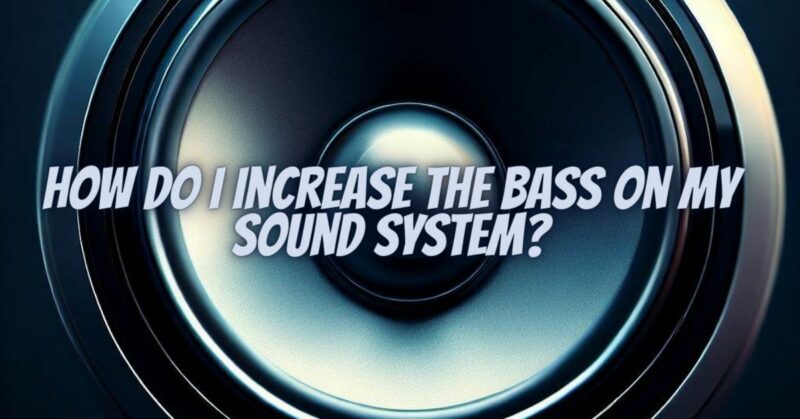The bass is the heartbeat of music, adding depth and vibrancy to your audio experience. Whether you’re a music lover, a movie buff, or a gamer, a sound system with robust bass can transform your auditory adventures. In this comprehensive article, we will explore various methods and techniques to help you increase the bass on your sound system and achieve that satisfying thump and rumble you desire.
1. Adjust the Equalizer Settings:
Most audio devices, including amplifiers, receivers, and audio players, feature an equalizer (EQ) that allows you to fine-tune the audio frequencies. To increase the bass, boost the lower frequencies (typically represented as “Bass” or “Low” on the EQ). Experiment with small adjustments until you find the right balance to suit your preferences and the type of content you’re enjoying.
2. Use a Subwoofer:
A subwoofer is a dedicated speaker designed to reproduce low-frequency sounds, such as bass and sub-bass. Adding a subwoofer to your sound system can significantly enhance the bass output. Position it strategically in your listening space, as subwoofer placement can affect bass quality. Experiment with subwoofer settings to achieve the ideal bass level and integration with your main speakers.
3. Upgrade Your Speakers:
If you’re looking for a more comprehensive bass upgrade, consider investing in speakers designed to deliver deeper and richer bass response. Look for models with larger woofers and enhanced bass drivers. Speaker placement and room acoustics also play a crucial role in optimizing bass performance.
4. Acoustic Treatment:
Improving the acoustics of your listening room can help maximize bass impact. Bass frequencies can be influenced by room size, shape, and furniture placement. Adding bass traps, diffusers, and absorbers can help mitigate unwanted bass reflections and standing waves, resulting in cleaner and more defined bass.
5. Bass-Boosting Features:
Many modern audio devices come equipped with bass-boosting features or presets. These settings are designed to enhance the low-frequency output. Check your device’s user manual or menu settings to see if there are bass-boosting options available.
6. Subwoofer Crossover Settings:
If you have a subwoofer, configure its crossover settings to ensure it handles the low-frequency content effectively. Crossover settings determine the point at which your main speakers hand off bass frequencies to the subwoofer. Properly setting the crossover ensures a seamless transition and avoids overlap, resulting in cleaner bass.
7. Use a Bass Enhancement Device:
Consider using external bass enhancement devices or processors. These devices analyze audio signals in real-time and add additional bass frequencies to the output. Some soundbars and home theater systems also come with built-in bass enhancement features.
8. Bass-Heavy Media and Content:
Choose media and content that are known for their bass-heavy tracks. Genres like hip-hop, electronic dance music (EDM), and action movies often feature impactful bass lines. Playing such content can accentuate the low end of your sound system.
9. Experiment and Fine-Tune:
Finding the perfect bass balance is a matter of personal preference. Take the time to experiment with different settings and configurations. Listen critically and make adjustments until you achieve the bass response that suits your taste and the type of content you enjoy.
Increasing the bass on your sound system can elevate your audio and entertainment experience. Whether you choose to adjust EQ settings, add a subwoofer, upgrade speakers, or optimize room acoustics, the key is to find the right balance that enhances the bass without overpowering other frequencies. With patience and experimentation, you can achieve a satisfying and immersive bass experience that complements your favorite music, movies, and games.


